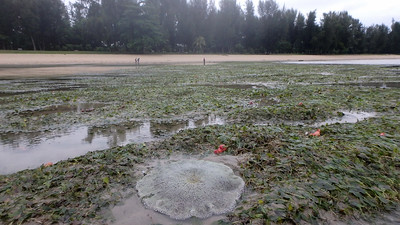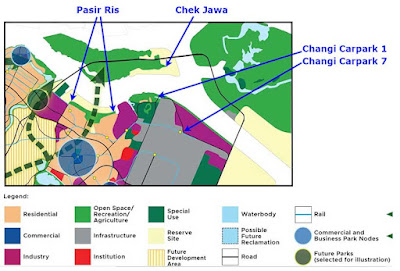 |
| Dugong feeding trails, hard to photograph in the dark! |
Kelvin found a small Pentaceraster sea star, similar in size to the many that we saw at Chek Jawa last month. He also saw a Knobbly sea star and small Biscuit star. I saw a small Baler snail, about 12cm long. It seems to have caught something in its large foot. Similar to our last survey in Jan 2024 and Jun 2023, I saw much fewer colourful sea cucumbers than in the past, with a more or less equal number of Pink warty sea cucumbers and Thorny sea cucumbers. Kelvin spotted a variety of sea cucumbers as well as some large White Salmacis sea urchins. Other interesting sightings was the empty shell of a Watering pot shell, which is a bivalve! Kelvin also spotted some seagrass pipefish which I haven't seen for a while.
I worry about mass coral bleaching which is seems to have arrived on some of shores recently. There are no corals at Changi, but other cnidarians can also bleach. So I was relieved to see no bleaching among the very many large Haddon's carpet anemones on the shores. Only one was quite pale, the rest were their usual happy colours. I saw a few Swimming anemones, which were nice and brown.
I saw furrows that might be dugong feeding trails on the seaward side beyond the sandbars exposed at super low tide seaward. Dugong feeding trails are formed when dugongs chomp up seagrasses including their roots, leaving a shallow meandering furrow of about equal width and depth. We saw similar signs here on our last survey in Jan 2024 and Jun 2023.
Seagrasses remain lush on this shore, and Needle seagrass with broad leaves seem to be the more abundant species, with lush growths of Needle seagrass with narrow leaves. There remains dense growths of Spoon seagrass with small and large leaves. I also saw a few small clumps of Fern seagrass today. The patch of Smooth ribbon seagrass near the high shore seems similar to what I last saw in Jan 2024 remaining at about 10m long and about 4m wide. I didn't see any Noodle seagrass which I first saw in Aug 2018.
I was wondering whether mass coral bleaching weather would affect the mussels there. The patch of horse mussels here seems much reduced from what I saw in Jan 2024. I didn't see any on the seaward side of the sand bars - these areas now densely covered in seagrass. There remains some patches (about 10m x 10m) towards the high shore, but most of the clams were either dead or heavily encrusted. We first noticed this during our Feb 2019 survey and the clams were still there in Aug 2019 and Nov 2019. In Jun 2023, the patch was about 15m by 15m in the middle of the intertidal area exposed at about 0.1m. There are now many patches of bare soft sand and seagrasses cover most of the area.
What is the fate of these shores?
There doesn't seem to be a change in 2013 plans to reclaim all of Pasir Ris, all of Changi from Carpark 1 to Carpark 7 and beyond, and reclaim Chek Jawa and Pulau Sekudu. These appear to remain in place in the Long-Term Plan Review. Including plans for a road link that starts at Pasir Ris, crosses to Pulau Ubin, right across Chek Jawa to Pulau Tekong, and back to the mainland at Changi East.
See Changi shores for yourself !
They are easy to get to, and enjoyed by many people. It remains rich in marine life. More details in "Changi - an easy intertidal adventure for the family".

Photos by Kelvin Yong

.jpg)
.jpg)
.jpg)
.jpg)
.jpg)
